A Narrative of Urban Underground Pipeline System Disasters in China in 2021: Spatial and Temporal Distribution, Causal Analysis, and Response Strategies
Abstract
1. Introduction
- Six–Thirteen Major Gas Explosion in Shiyan City
- Zhengzhou ‘7.20’ rainstorm event
2. Spatial and Temporal Distribution of Underground Pipeline Accident Disasters in China in 2021
2.1. Data Sheet
2.2. Accident Statistics and Analysis
2.2.1. Main Types of Accidents
- (1)
- Manifestation of accidents
- (2)
- Underground pipeline damage accidents.
2.2.2. Main Causes of Accidents
- (1)
- Underground pipeline damage accidents.
- (2)
- Pavement collapse accidents
2.3. Time Distribution Trend
2.3.1. Underground Pipeline Damage Accident
2.3.2. Road Cave-In Accidents
2.4. Spatial Distribution
2.4.1. Scope Distribution
2.4.2. Province Distribution
3. Analysis of the Main Types of Underground Pipelines in China in 2021
3.1. Problems of Main Types of Underground Pipelines
3.1.1. Underground Water Supply Pipeline
3.1.2. Underground Drainage Pipeline
3.1.3. Underground Gas Pipeline
3.2. Road Collapses
4. Correlation Analysis of the Causes of Underground Pipeline Disasters
4.1. Index Selection
4.2. Method
4.2.1. Pearson’s Correlation Coefficient
4.2.2. Regression Analysis
4.2.3. Coefficient of Determination
4.3. Results
4.3.1. Results of the Correlation Analysis
4.3.2. Results of the Regression Analysis
5. Discussion
5.1. Main Causes of Urban Underground Pipeline Disasters in China in 2021
5.2. Trend of Underground Pipeline Disasters in China
5.3. Causes and Countermeasures
5.4. Future Management of Urban Underground Pipelines
- Underground pipeline safety life cycle management.
- Information management based on digital twin technology.
- Regulations on underground pipeline construction, management, and informatization development.
6. Conclusions
Author Contributions
Funding
Institutional Review Board Statement
Informed Consent Statement
Data Availability Statement
Acknowledgments
Conflicts of Interest
References
- Guang, Y. Characteristics of Underground Pipeline Deformation and Damage under the Influence of Urban Tunnel Construction and the Mechanism of Leakage; Beijing Jiaotong University: Beijing, China, 2017. [Google Scholar]
- Zhaogang, H. Research on Ground Penetrating Radar Signal Analysis and Localization Method for Underground Pipeline Leakage; Guangzhou University: Guangzhou, China, 2022; Volume 2022. [Google Scholar]
- Lin, C.; Chengyong, Y.; Wenhui, M.; Jingke, C. Deformation calculation and experimental study on buried pipes induced by subway tunnel excavation. Huazhong Univ. Sci. Technol. Nat. Sci. Ed. 2022, 50, 7–13. [Google Scholar] [CrossRef]
- Dong, X. Analysis of Environmental Factors Impact on Urban Underground Pipelines. Adv. Mater. Res. 2014, 1065–1069, 2570–2576. [Google Scholar]
- Kewen, Y. Protection analysis of underground pipelines in municipal engineering construction. China High-Tech 2022, 2022, 54–55. China High-Tech. 2022, 2022, 54–55. [Google Scholar] [CrossRef]
- Kaihe, P. Study on the causes and countermeasures of urban natural gas pipeline accidents based on the "June 13" gas explosion accident in Shiyan. Ind. Saf. Environ. Prot. 2022, 48, 20–22. [Google Scholar]
- Zhouying, C.; Feng, K. Study on fragmentation of emergency management during“7·20”extreme rainstorm flood disaster in Zhengzhou of Henan Province and relevant comprehensive treatment. Water Resour. Hydropower Eng. 2022, 2022, 1–14. [Google Scholar]
- Mahmoodi, E.; Mortazavi, S.B.; Ahmadi, O.; Mahabadi, H.A. Analysis of Liquid Pipelines Accidents Causes, Consequences and Contributing Factors: A Review Study. J. Fail. Anal. Prev. 2021, 21, 348–362. [Google Scholar] [CrossRef]
- Belvederesi, C.; Thompson, M.S.; Komers, P.E. Statistical analysis of environmental consequences of hazardous liquid pipeline accidents. Heliyon 2018, 4, e00901. [Google Scholar] [CrossRef]
- Metropolo, P.L.; Brown, A.E.P. Natural gas pipeline accident consequence analysis. Process Saf. Prog. 2004, 23, 307–310. [Google Scholar] [CrossRef]
- Siler-Evans, K.; Hanson, A.; Sunday, C.; Leonard, N.; Tumminello, M. Analysis of pipeline accidents in the United States from 1968 to 2009. Int. J. Crit. Infrastruct. Prot. 2014, 7, 257–269. [Google Scholar] [CrossRef]
- Naik, D.L.; Kiran, R. Data Mining and Equi-Accident Zones for US Pipeline Accidents. J. Pipeline Syst. Eng. Pract. 2018, 9, 04018019. [Google Scholar] [CrossRef]
- Xing, J.; Meng, H.; Meng, X. An urban pipeline accident model based on system engineering and game theory. J. Loss Prev. Process Ind. 2020, 64, 104062. [Google Scholar] [CrossRef]
- Yuanhong, G.; Shuyan, W. Research of the urban under ground Pipeline Emergency Based on the Theory of Crisis Life Cycle. J. Liaoning Univ. Philos. Soc. Sci. 2017, 45, 18–23. [Google Scholar] [CrossRef]
- Yuanhong, G.; Jun, W. Research on crisis management ability of underground pipeline accident in Shenyang. J. Liaoning Econ. Vocat. Technol. Inst. 2017, 2017, 28–30. [Google Scholar]
- Wei, H. Analysis and discussion on safety problems of urban underground pipelines. Urban Rural. Dev. 2021, 2021, 45–47. [Google Scholar]
- Sinha, S.K.; McKim, R.A. Probabilistic based integrated pipeline management system. Tunn. Undergr. Space Technol. Inc. Trenchless Technol. Res. 2007, 22, 543–552. [Google Scholar] [CrossRef]
- Yuzevych, L.; Skrynkovskyy, R.; Koman, B. Development of Information Support of Quality Management of Underground Pipelines. Eureka Phys. Eng. 2017, 10, 49–60. [Google Scholar] [CrossRef]
- Yong, W. Study and Application of Detection Techniques and Methods of Urban Underground Pipelines; Jilin University: Changchun, China, 2012. [Google Scholar]
- Jun, C.; Yonghui, Z.; Minghao, W. The Application of Ground-Penetrating-Radar in Prospecting Underground Pipeline. Chin. J. Eng. Geophys. 2005, 2005, 260–263. [Google Scholar]
- Yan, W.; Yongqiang, J.; Yan, L. Application of 3D Ground Penetrating Radar on Urban Underground Pipeline Detection. Geomat. Spatal Inf. Technol. 2022, 45, 212–214. [Google Scholar]
- Jaw, S.W.; Hashim, M. Urban Underground Pipelines Mapping Using Ground Penetrating Radar. IOP Conf. Ser. Earth Environ. Sci. 2014, 18, 012167. [Google Scholar] [CrossRef]
- Jaw, S.W.; Hashim, M. Locational accuracy of underground utility mapping using ground penetrating radar. Tunn. Undergr. Space Technol. Inc. Trenchless Technol. Res. 2013, 35, 20–29. [Google Scholar] [CrossRef]
- Shunzhi Mole, Z.H. Research and Implementation of Integrated Urban Underground Pipelines Management System Based on Geodatabase; Xiamen University: Xiamen, China, 2007. [Google Scholar]
- Qihu, Q.; Xiaoqiang, C. Situation, Problems and Countermeasures of Utility Tunnel’ Development in China and Abroad. Chin. J. Undergr. Space Eng. 2007, 2007, 191–194. [Google Scholar]
- Dayong, L.; Xiaonan, G.; Tuqiao, Z. Numerical simulation of the buried pipelines protection adjacent to deep excavation. Chin. J. Geotech. Eng. 2001, 2001, 736–740. [Google Scholar]
- Sultanov, K.S. Parameters of Nonlinear Laws of Longitudinal Interaction of Underground Pipelines with Soil. Soil Mech. Found. Eng. 2022, 59, 347–353. [Google Scholar] [CrossRef]
- Aiwen, L. Response Analysis of a Buried Pipeline Crossing The Fault Based on Shell-Model; Institute of Geophysics, China Seismological Bureau: Beijing, China, 2002. [Google Scholar]
- Qingquan, L.; Yong, Y.; Bisheng, Y.; Xianghong, H. Research on 3D Visualization of Underground Pipeline. Geomat. Inf. Sci. Wuhan Univ. 2003, 2003, 277–282. [Google Scholar]
- Zhou, C.Y.; Huang, L.J. Application of Three-Dimension Visualization Technology in Water Supply Pipeline Information System Based on VTK. Adv. Mater. Res. 2012, 1684, 558–561. [Google Scholar]
- Bo, W.; Bo, G. 3D numerical simulation on effect of tunnel construction on adjacent pipeline. Chin. J. Rock Mech. Eng. 2002, 2002, 2451–2456. [Google Scholar]
- Ping, S.; Li, W.; Kehui, L.; Lini, X.; Qiuju, Y. Identification of dangerous factors and accident preventive measures of urban underground heating pipeline. J. Saf. Sci. Technol. 2008, 2008, 130–133. [Google Scholar]
- Zhen, R. Analysis on Key Points of External Damage Prevention Management of Underground Gas Pipeline. Shanghai Gas 2001, 2021, 27–29. [Google Scholar]
- Biezma, M.V.; Agudo, D.; Barron, G. A Fuzzy Logic method: Predicting pipeline external corrosion rate. Int. J. Press. Vessel. Pip. 2018, 163, 55–62. [Google Scholar] [CrossRef]
- El-Abbasy, M.S.; Senouci, A.; Zayed, T.; Mirahadi, F.; Parvizsedghy, L. Condition Prediction Models for Oil and Gas Pipelines Using Regression Analysis. J. Constr. Eng. Manag. 2014, 140, 04014013. [Google Scholar] [CrossRef]
- Cho, Y.; Smits, K.M.; Riddick, S.N.; Zimmerle, D.J. Calibration and field deployment of low-cost sensor network to monitor underground pipeline leakage. Sens. Actuators B Chem. 2022, 355, 131276. [Google Scholar] [CrossRef]
- Datta, S.; Sarkar, S. A review on different pipeline fault detection methods. J. Loss Prev. Process Ind. 2016, 41, 97–106. [Google Scholar] [CrossRef]
- Jain, R.K.; Abhijit, D.; Arpita, M.; Ray, D.N.; Pratap, K. Experimental Performance of Robotic Inspection System for Underground Pipelines. J. Inst. Eng. Ser. C 2021, 102, 683–703. [Google Scholar] [CrossRef]
- Liu, X.; Liu, J.; Guo, S. GIS-based Fuzzy Comprehensive Evaluation on Underground Gas Pipeline Risk. Energy Procedia 2011, 11, 3911–3917. [Google Scholar]
- Qureshi, M.S.; Aljarbouh, A.; Fayaz, M.; Qureshi, M.B.; Mashwani, W.K.; Khan, J. An Efficient Methodology for Water Supply Pipeline Risk Index Prediction for Avoiding Accidental Losses. Int. J. Adv. Comput. Sci. Appl. 2020, 11, 385–393. [Google Scholar] [CrossRef]
- Priyanka, E.B.; Thangavel, S.; Gao, X.Z.; Sivakumar, N.S. Digital twin for oil pipeline risk estimation using prognostic and machine learning techniques. J. Ind. Inf. Integr. 2022, 26, 100272. [Google Scholar] [CrossRef]
- Belvederesi, C.; Dann, M.R. Statistical analysis of failure consequences for oil and gas pipelines. Int. J. Saf. Secur. Eng. 2017, 7, 103–112. [Google Scholar] [CrossRef]
- Jamshidi, A.; Yazdani-Chamzini, A.; Yakhchali, S.H.; Khaleghi, S. Developing a new fuzzy inference system for pipeline risk assessment. J. Loss Prev. Process Ind. 2013, 26, 197–208. [Google Scholar] [CrossRef]
- Dawood, T.; Elwakil, E.; Novoa, H.M.; Delgado, J.F.G. Soft computing for modeling pipeline risk index under uncertainty. Eng. Fail. Anal. 2020, 117, 104949. [Google Scholar] [CrossRef]
- Urbina, A.G.; Aoyama, A. Pipeline risk assessment using artificial intelligence: A case from the colombian oil network. Process Saf. Prog. 2018, 37, 110–116. [Google Scholar] [CrossRef]
- Zhiqiang, X.; Qingyun, D.; Zhong, G.; Guiwu, W.; Wei, H. Underground Pipeline Universal GIS Platform Construction and Its Application in the Management of Urban Drainage. Bull. Surv. Mapp. 2012, 2012, 72–75. [Google Scholar]
- Hongyun, W.; Yongsheng, L.; Yunliang, W.; Liyan, L. Influence of urban drains network to drainage system safety operation. Beijing Water 2006, 2006, 17–19. [Google Scholar]
- Huizhou, Y.; Xiaoxiong, W.; Jiajia, Y. Analysis and prevention measures of municipal drainage pipeline in south city of China. Water Wastewater Eng. 2021, 57, 112–116+122. [Google Scholar] [CrossRef]
- Zhengyang, Q. City gas accident cases and preventive measures. In Proceedings of the 2019 Gas Safety Exchange Seminar and the 5th National Urban Gas Safety and Service Research Activity of “Diners Cup”, Hefei, China, 12 December 2019; pp. 357–359. [Google Scholar]
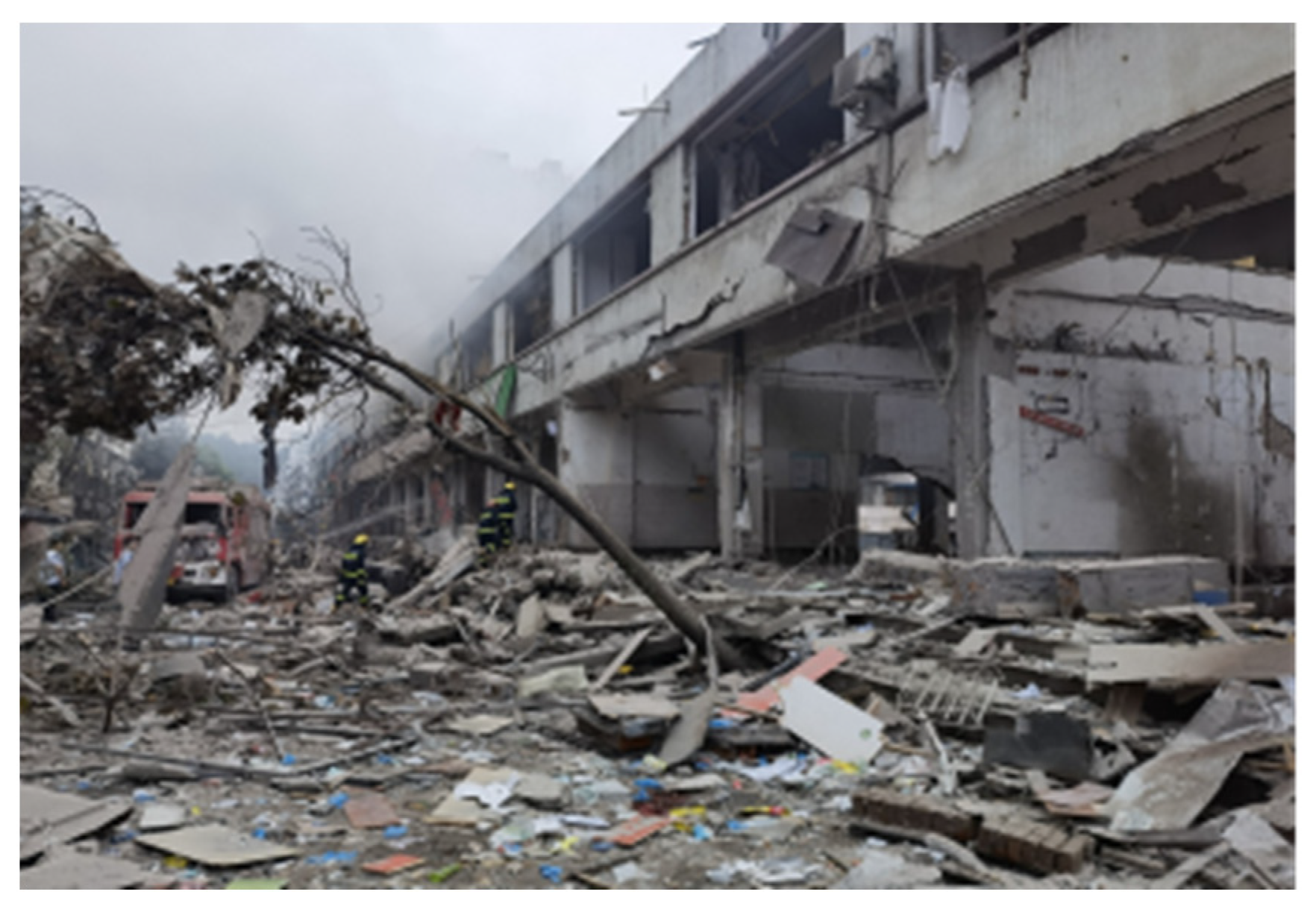
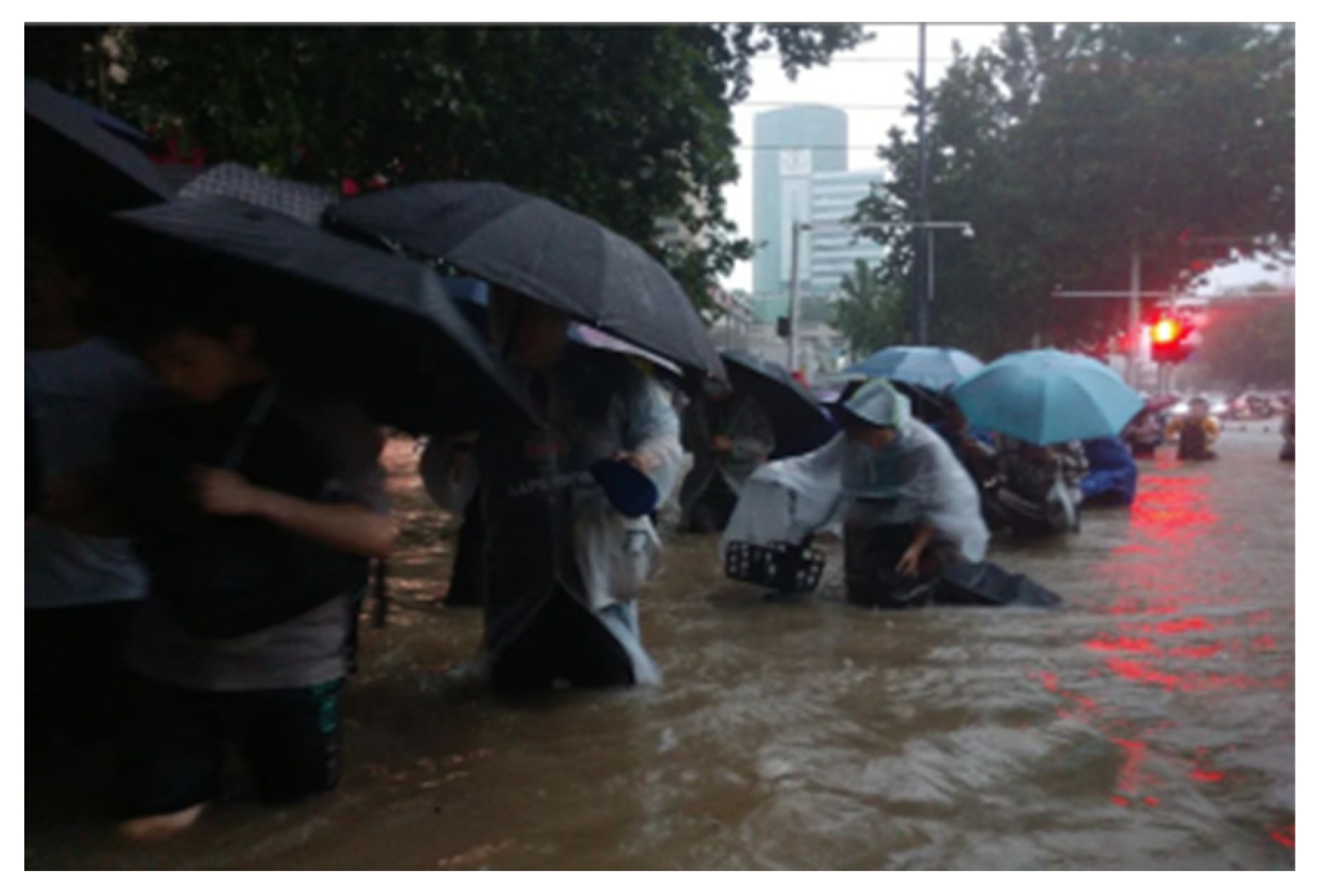
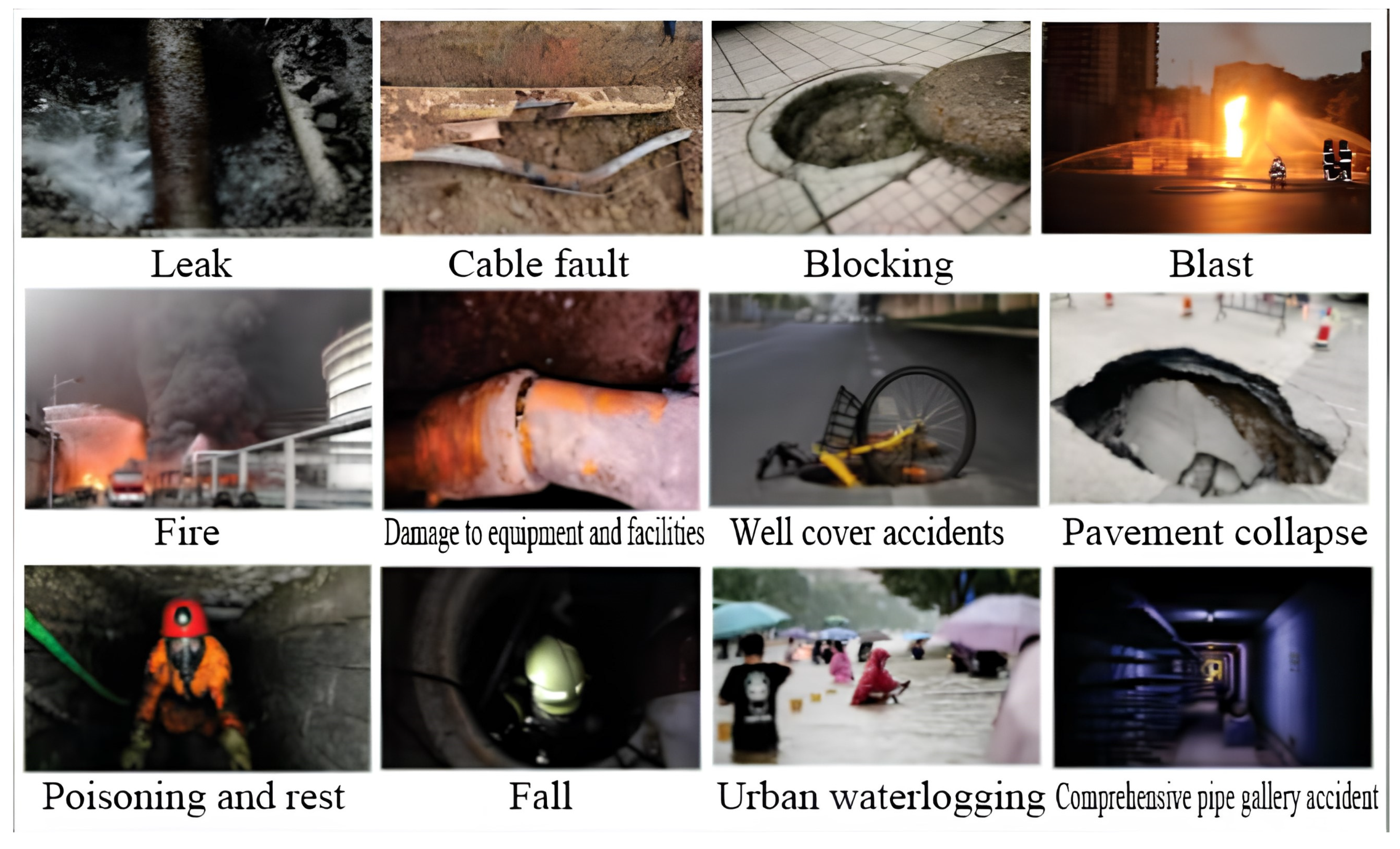
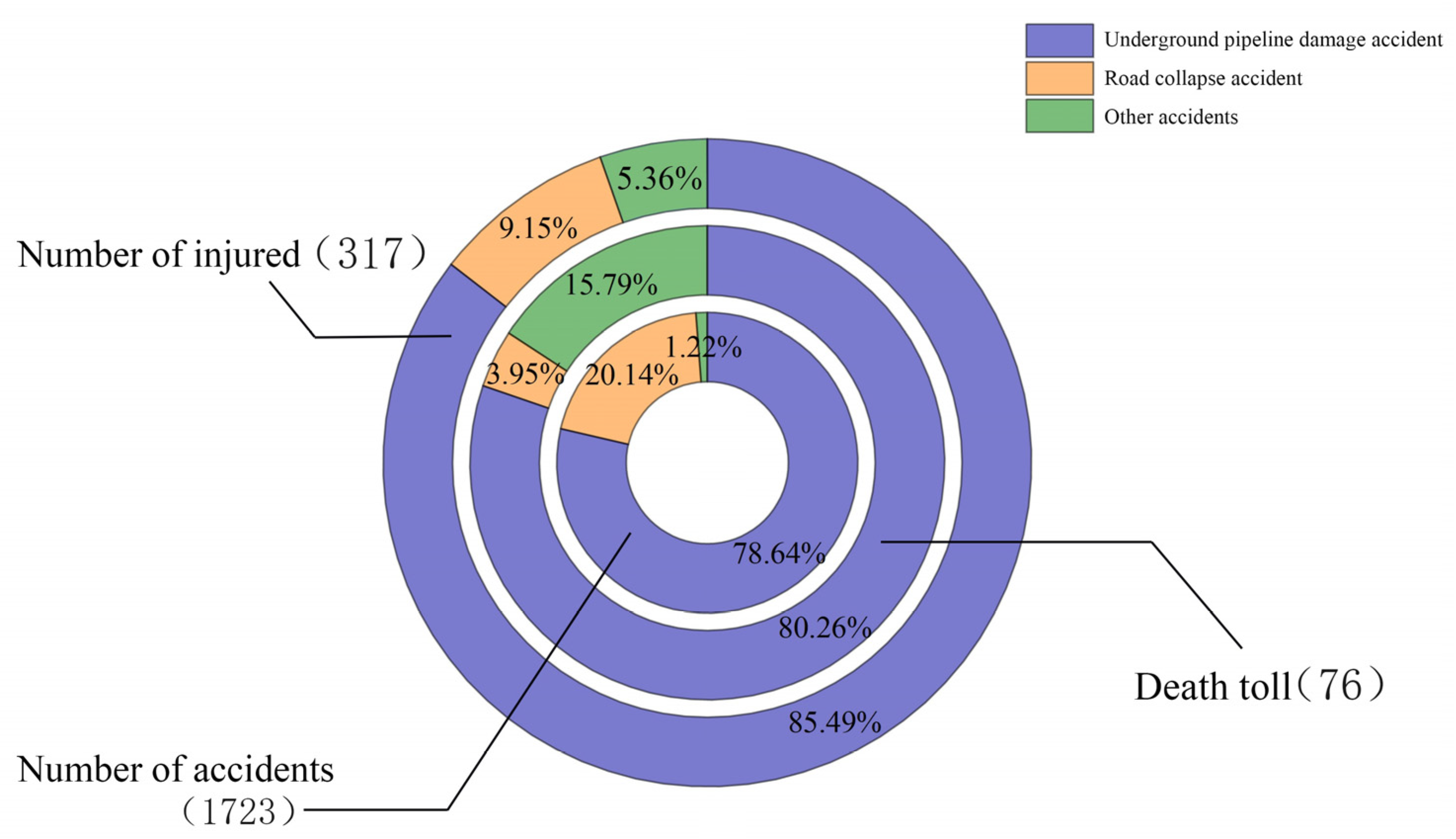
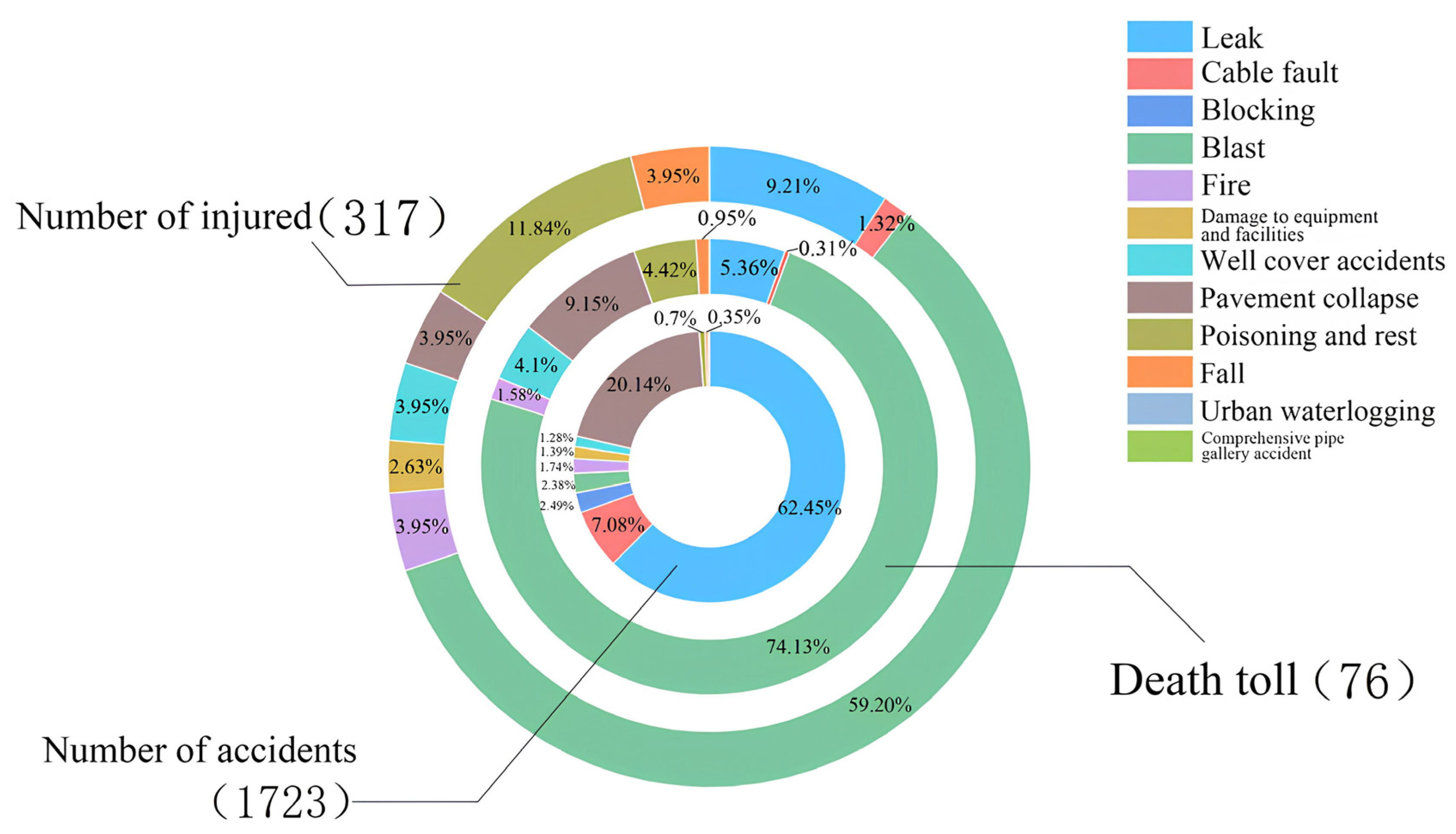
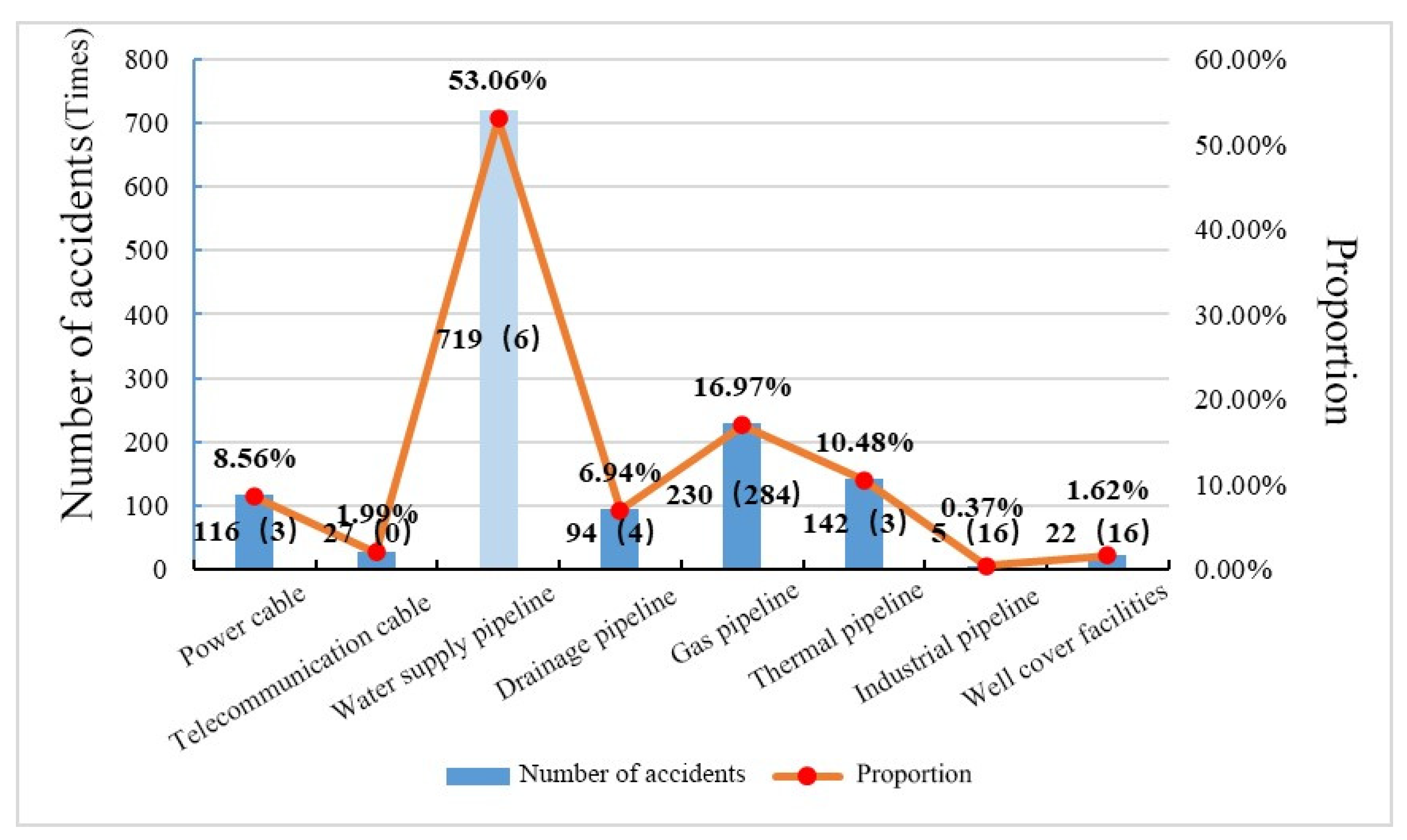
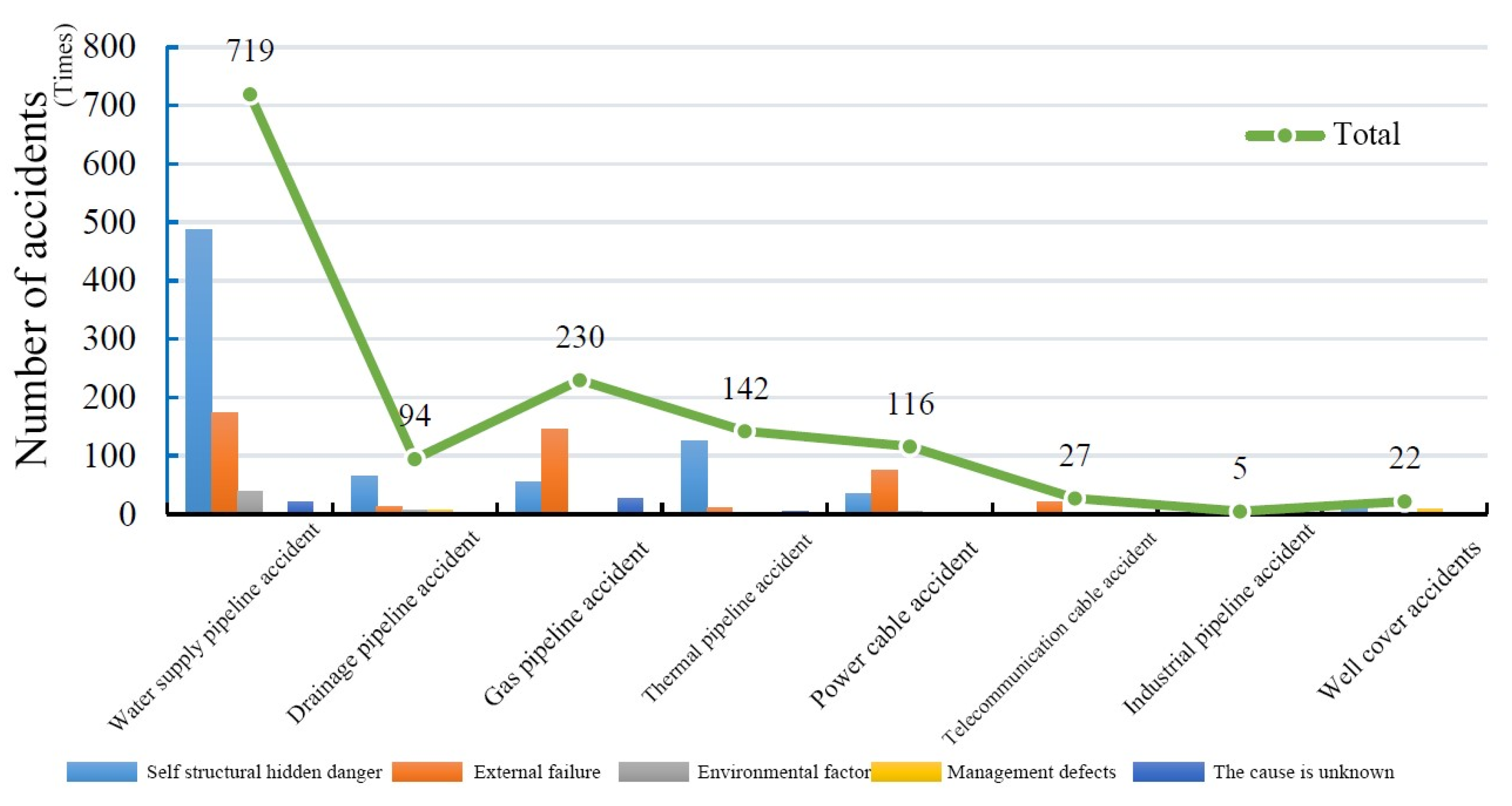
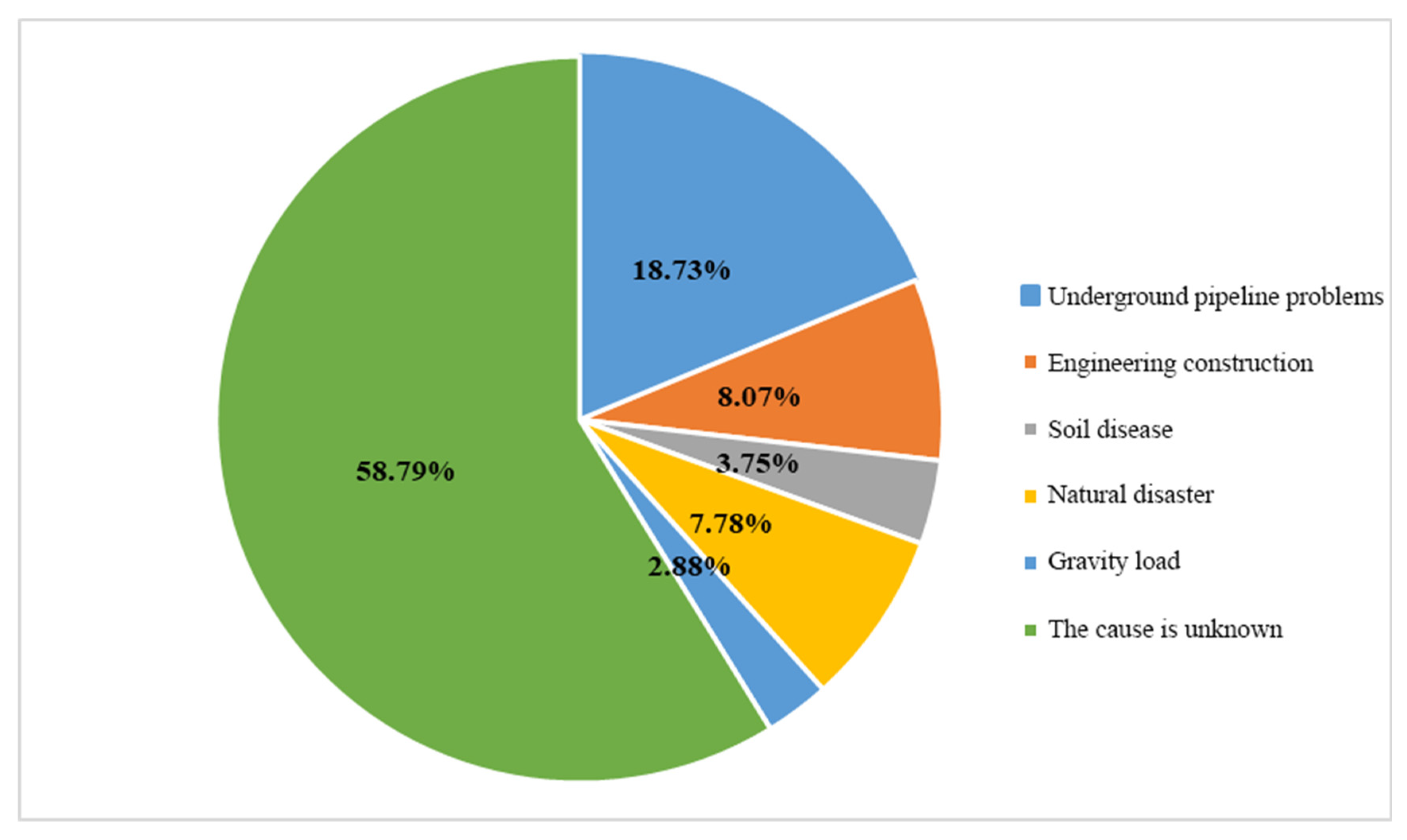
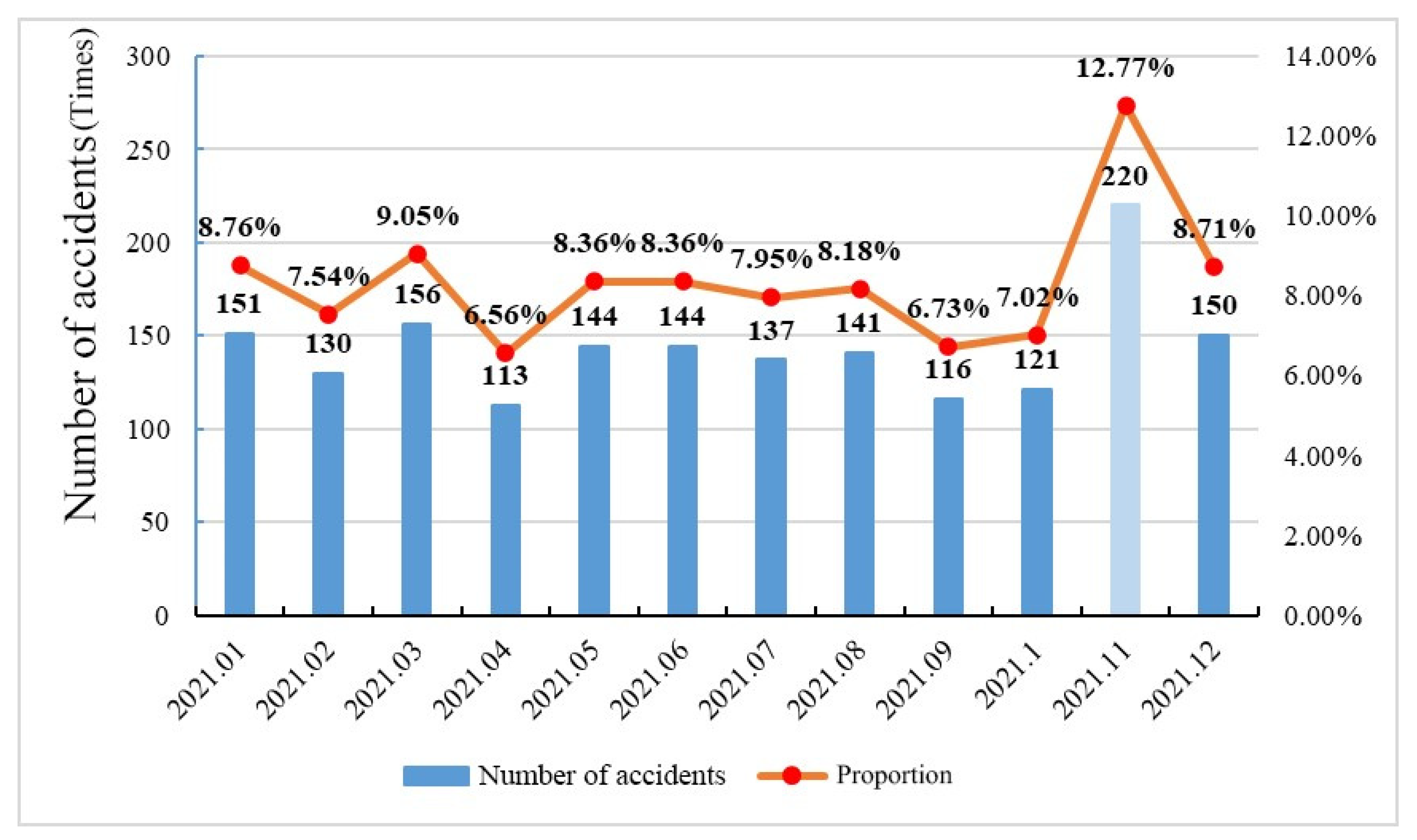
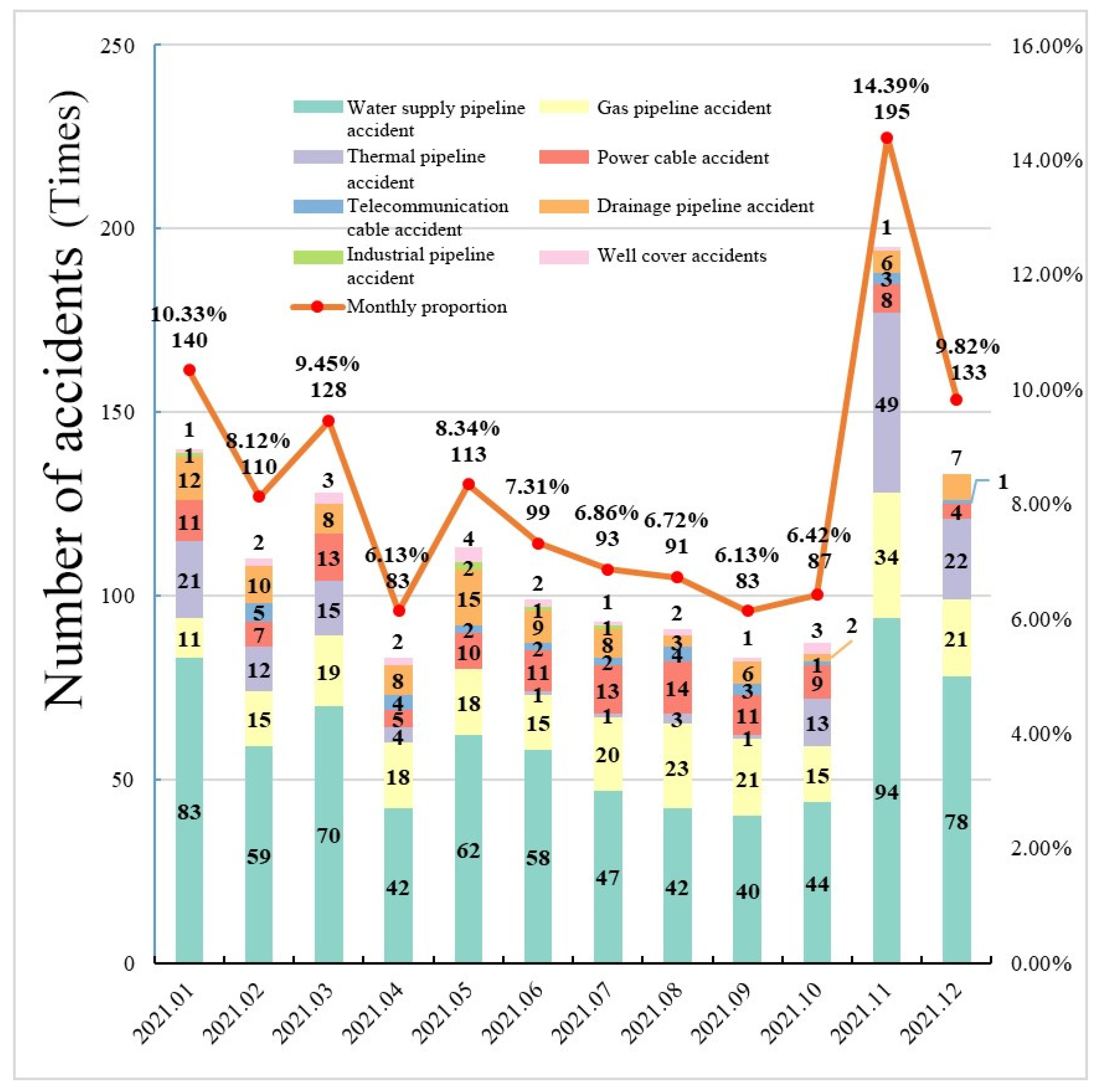
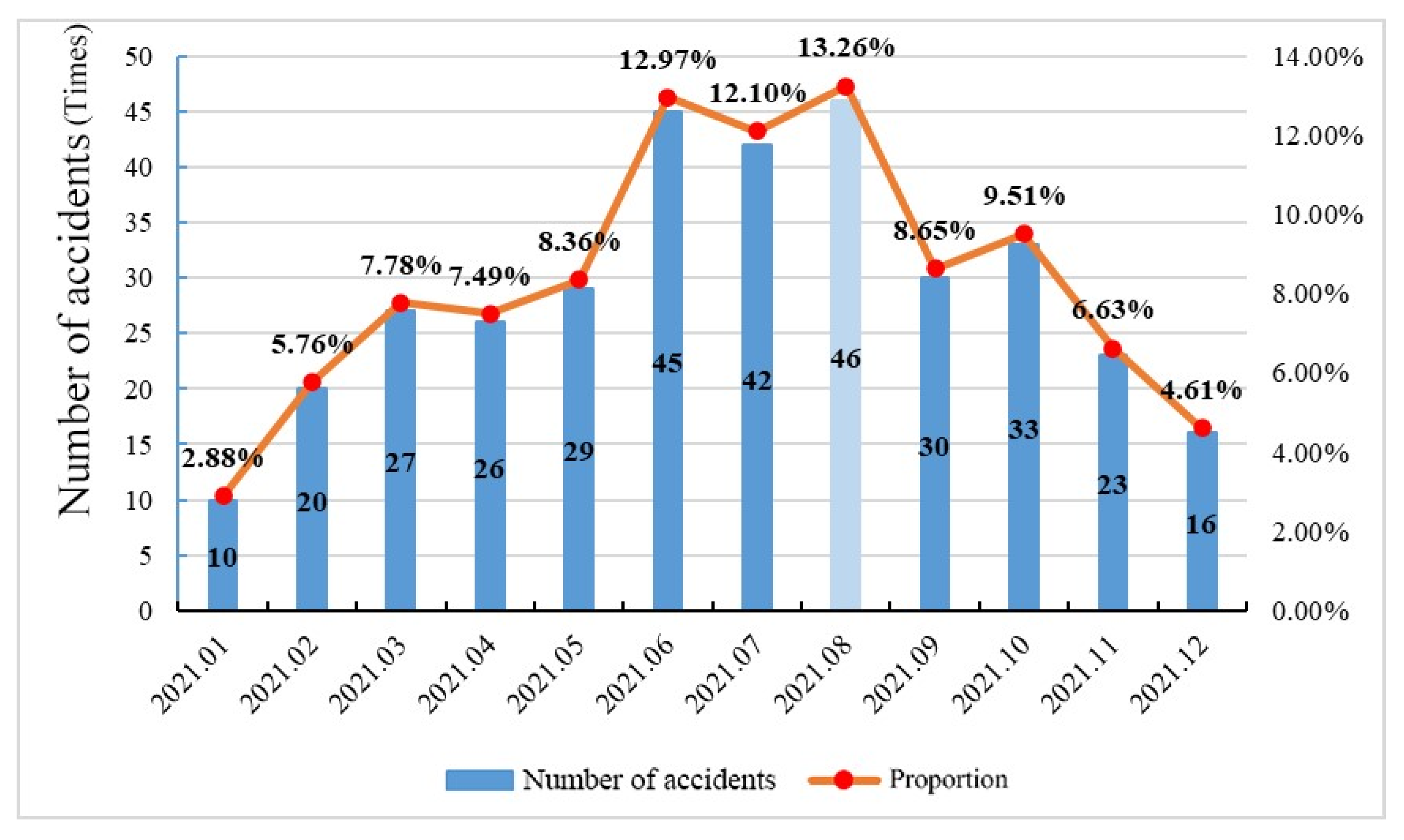
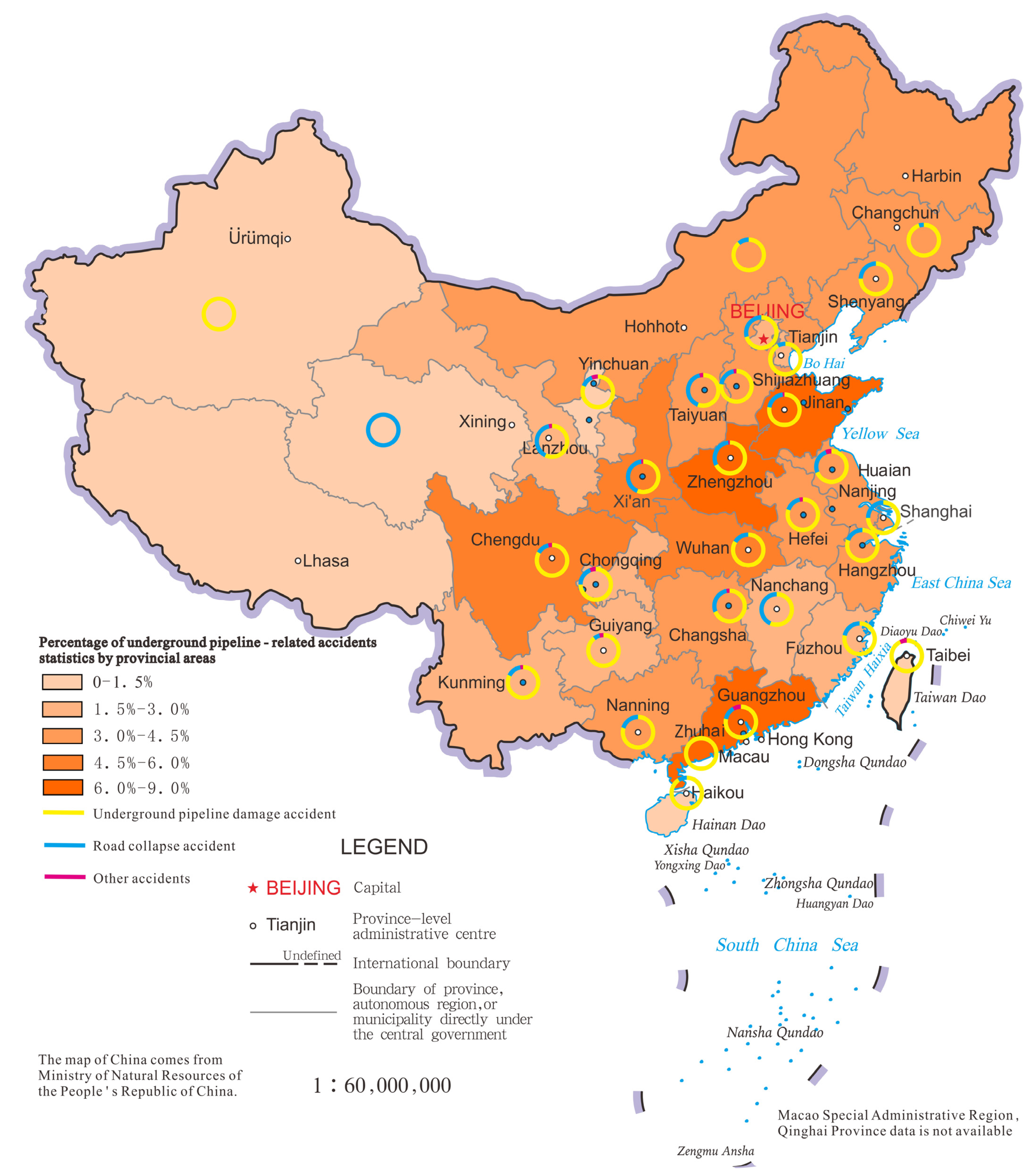
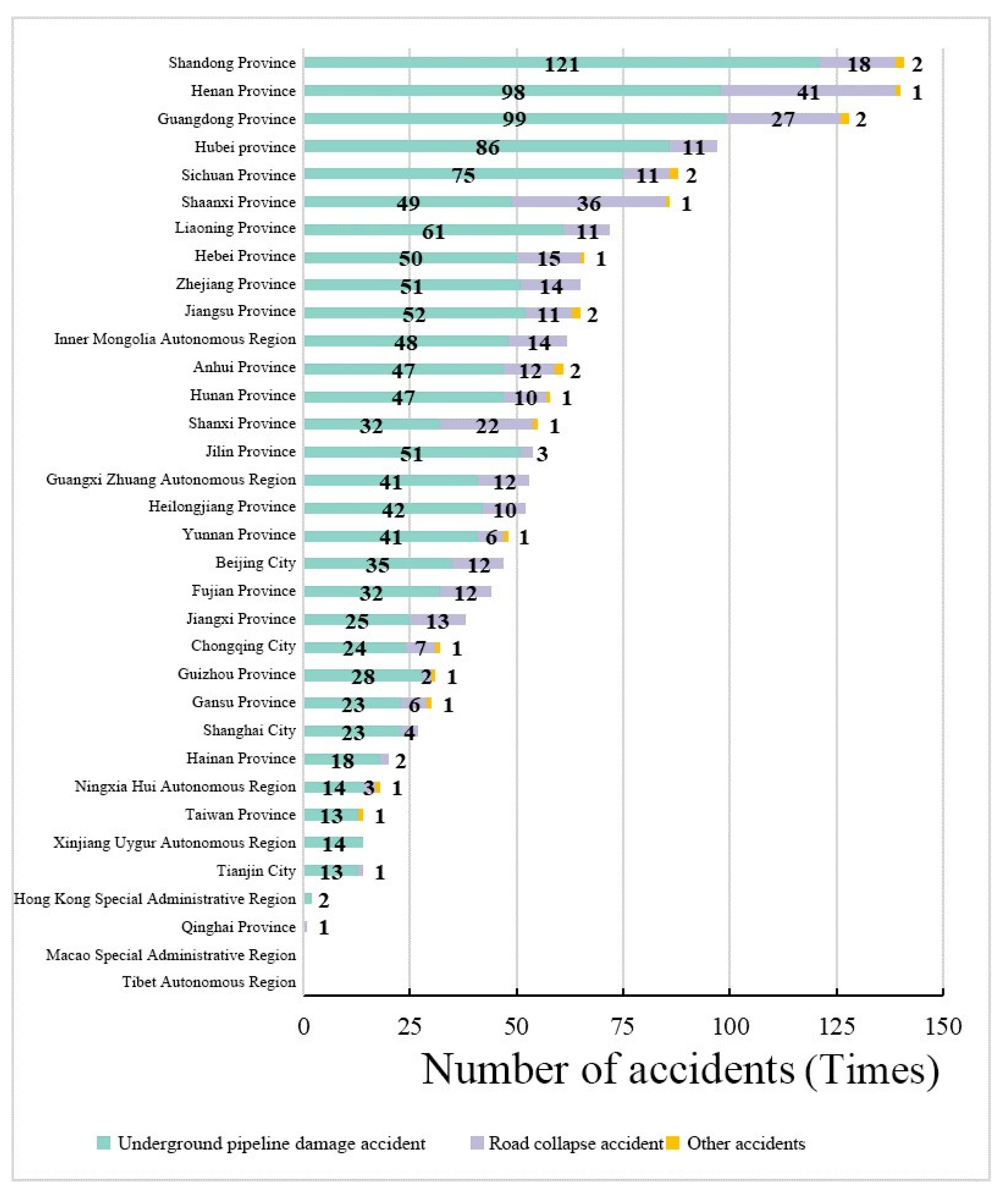
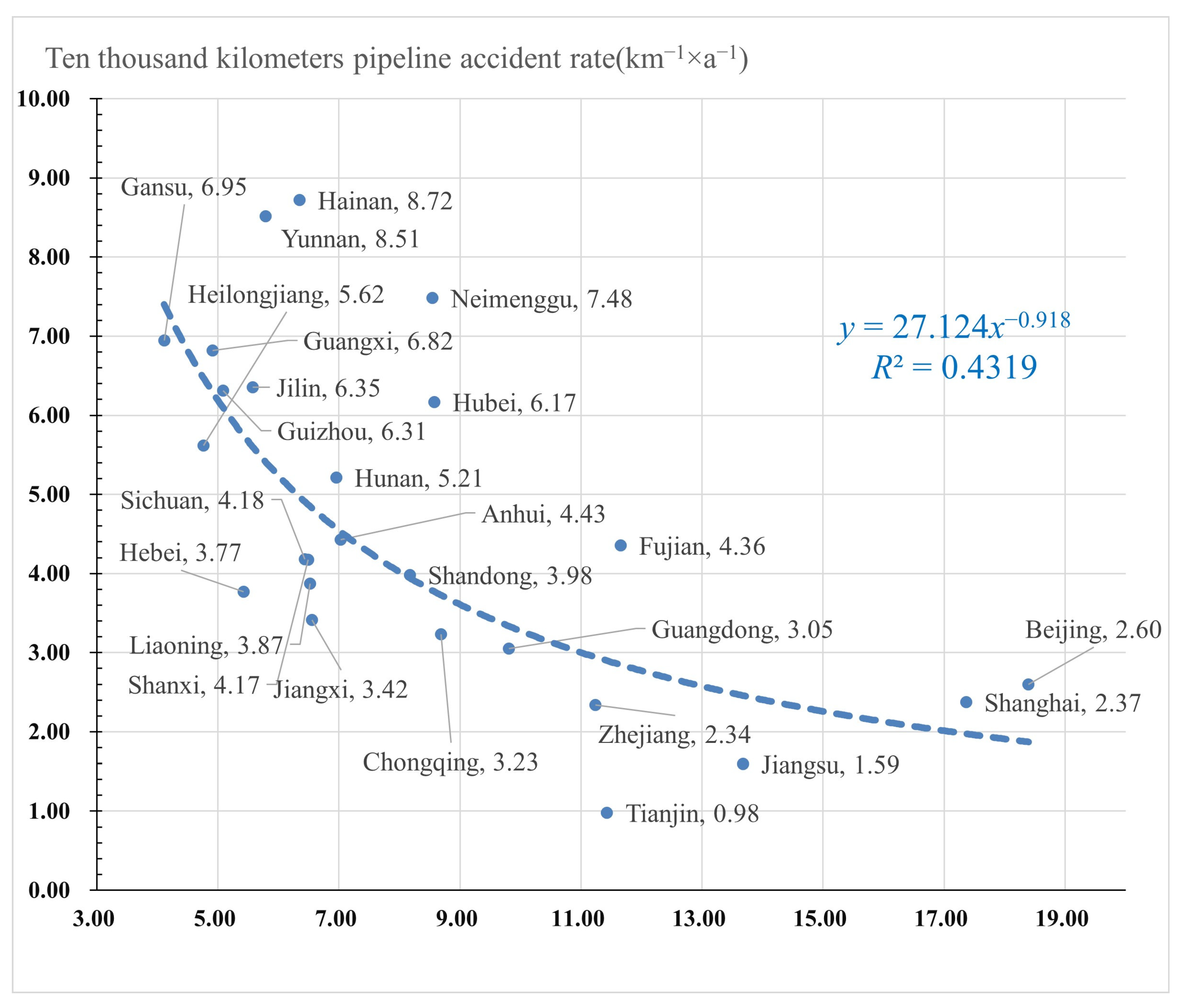
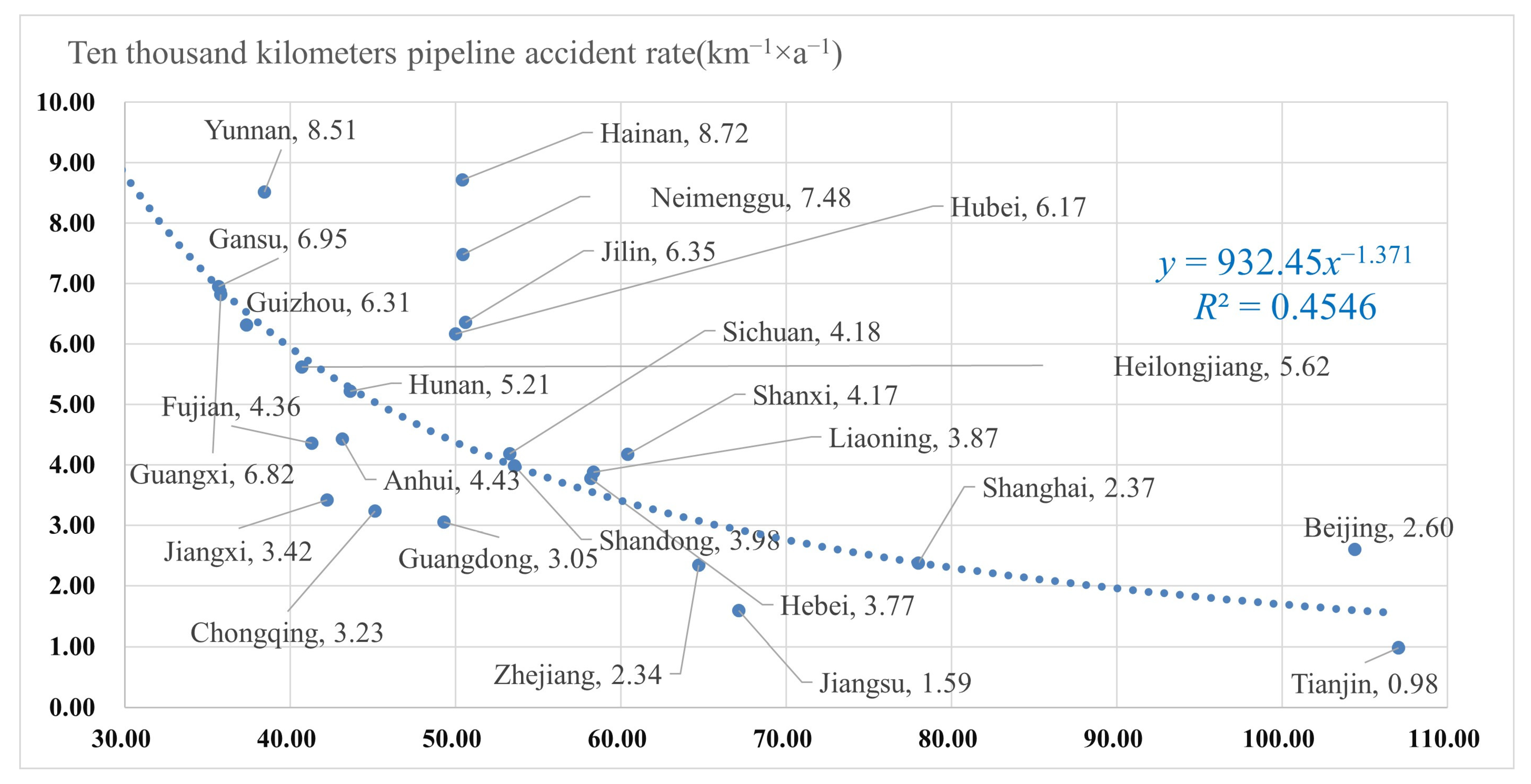
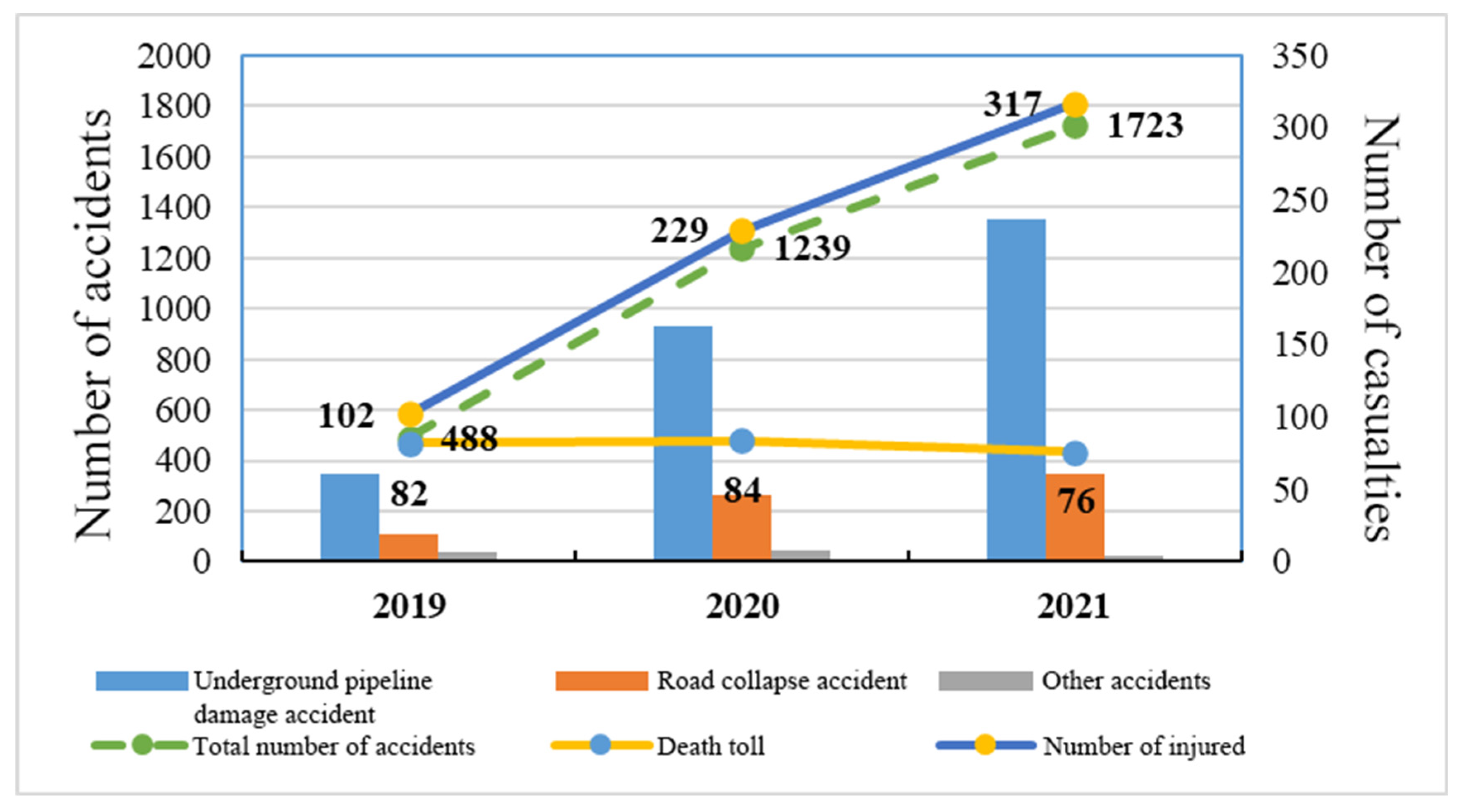
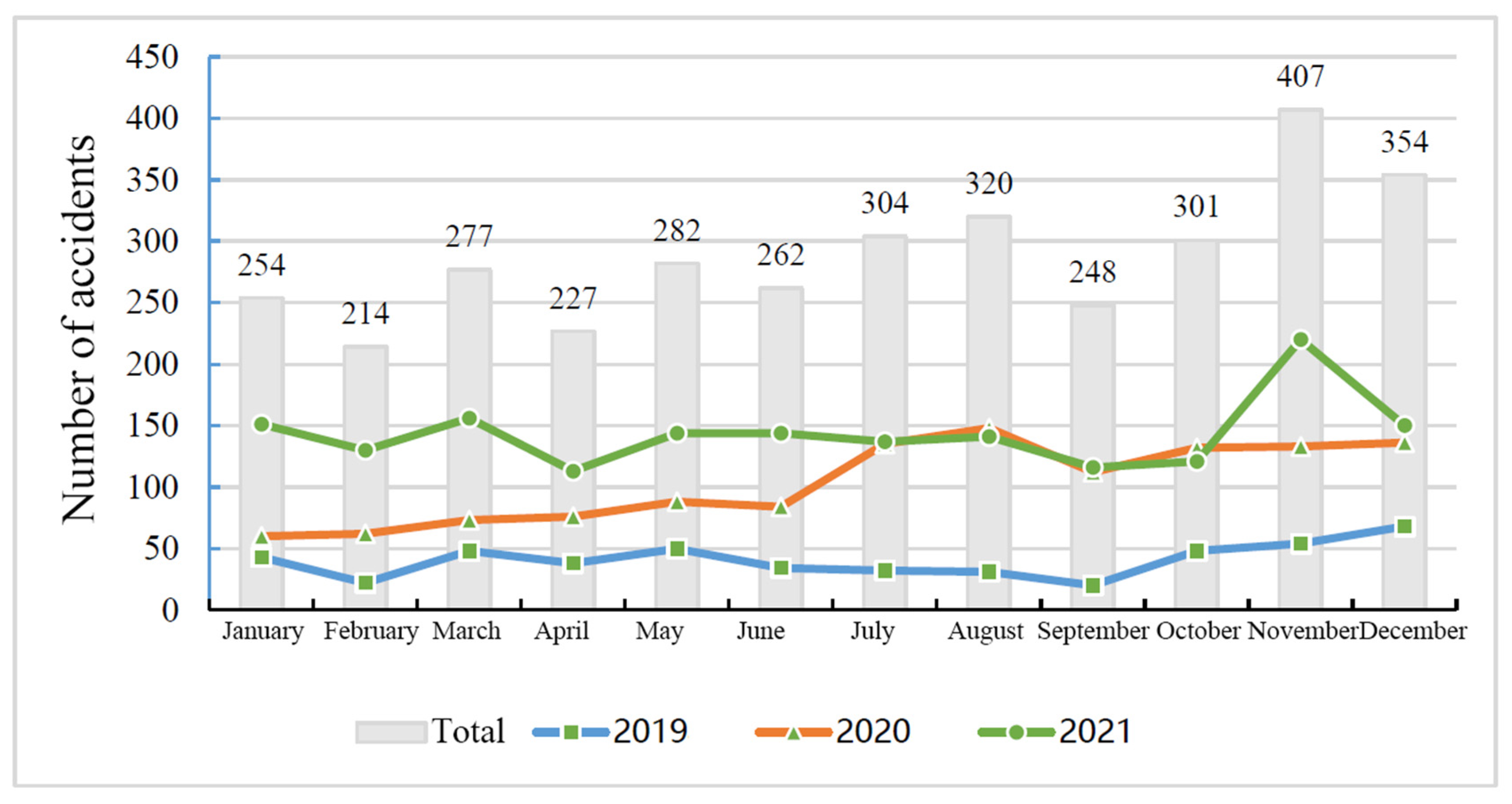
| Provinces and Cities | Ten Thousand Kilometers Pipeline Accident Rate (km−1 × a−1) | Per Capita GDP (Million Yuan) | Pipeline Density of Built-Up Area (km/km2) |
|---|---|---|---|
| Beijing | 2.60 | 18.40 | 104.40 |
| Tianjin | 0.98 | 11.43 | 107.06 |
| Hebei | 3.77 | 5.42 | 58.19 |
| Shanxi | 4.17 | 6.49 | 60.44 |
| Inner Mongolia | 7.48 | 8.55 | 50.46 |
| Liaoning | 3.87 | 6.52 | 58.36 |
| Jilin | 6.35 | 5.57 | 50.62 |
| Heilongjiang | 5.62 | 4.76 | 40.72 |
| Shanghai | 2.37 | 17.36 | 78.00 |
| Jiangsu | 1.59 | 13.68 | 67.15 |
| Zhejiang | 2.34 | 11.24 | 64.74 |
| Anhui | 4.43 | 7.03 | 43.16 |
| Fujian | 4.36 | 11.66 | 41.32 |
| Jiangxi | 3.42 | 6.56 | 42.24 |
| Shandong | 3.98 | 8.17 | 53.58 |
| Henan | 9.24 | 5.96 | 32.78 |
| Hubei | 6.17 | 8.58 | 50.02 |
| Hunan | 5.21 | 6.96 | 43.64 |
| Guangdong | 3.05 | 9.81 | 49.30 |
| Guangxi | 6.82 | 4.91 | 35.80 |
| Hainan | 8.72 | 6.35 | 50.41 |
| Chongqing | 3.23 | 8.68 | 45.13 |
| Sichuan | 4.18 | 6.43 | 53.30 |
| Guizhou | 6.31 | 5.08 | 37.37 |
| Yunnan | 8.51 | 5.79 | 38.46 |
| Shaanxi | 8.18 | 7.54 | 39.25 |
| Gansu | 6.95 | 4.11 | 35.70 |
| Qinghai | 0.00 | 5.63 | 55.82 |
| Xinjiang | 2.62 | 6.17 | 40.16 |
| Tibet | 0.00 | 5.68 | 54.10 |
| Ningxia | 23.36 | 6.24 | 12.10 |
| Linear Fitting | Power Function Fitting | |||
|---|---|---|---|---|
| Formula | Formula | |||
| Per capita GDP | 0.4019 | 0.4810 | ||
| Pipeline density | 0.4275 | 0.5827 | ||
| Number | Province/City | Local Regulations on Underground Pipelines | Publishing Unit | Implementation Date |
|---|---|---|---|---|
| W | Hebei Province | Regulations on Underground Pipelines in Cities of Hebei Province | Standing Committee of Hebei Provincial People’s Congress | 1 September 2015 |
| 2 | Taiyuan City | Regulations on Underground Pipelines in Cities of Taiyuan | Standing Committee of Taiyuan Municipal People’s Congress | 1 May 2016 |
| 3 | Nanjing City | Pipelines Management Regulations in Nanjing | Standing Committee of Nanjing Municipal People’s Congress | 1 September 2018 |
| 4 | Huai’an City | Regulations on Underground Pipeline Management in Huai’an City | Standing Committee of Huaian Municipal People’s Congress | 1 November 2017 |
| 5 | Hangzhou City | Regulations on Urban Underground Pipeline Construction and Management in Hangzhou | Standing Committee of Hangzhou Municipal People’s Congress | 1 January 2009 |
| 6 | Hefei City | Regulations on Underground Pipeline Management in Hefei City | Standing Committee of Hefei Municipal People’s Congress | 1 March 2019 |
| 7 | Qingdao City | Regulations on Underground Pipeline Management in Qingdao City | Standing Committee of Qingdao Municipal People’s Congress | 1 November 2016 |
| 8 | Zibo City | Regulations on Underground Pipeline Management in Zibo City | Standing Committee of Zibo Municipal People’s Congress | 1 January 2017 |
| 9 | Changsha City | Regulations on Underground Pipeline Management in Chongqing City | Standing Committee of Changsha Municipal People’s Congress | 1 January 2017 |
| 10 | Zhuhai City | Regulations on Archives Management of Urban Underground Pipeline Engineering in Changsha City | Standing Committee of Zhuhai Municipal People’s Congress | 1 May 2005 |
| 11 | Chongqing City | Regulations on Underground Pipeline Management in Zhuhai City | Standing Committee of Chongqing Municipal People’s Congress | 1 August 2009 |
| 12 | Yibin City | Regulations on Urban Pipeline in Chongqing City | Standing Committee of Yibin Municipal People’s Congress | 1 January 2017 |
| 13 | Kunming City | Regulations on Underground Pipeline Management in Yibin City | Standing Committee of Kunming Municipal People’s Congress | 1 October 2018 |
| 14 | Shaanxi Province | Regulations on Underground Pipeline Management in Kunming City | Standing Committee of Shaanxi Provincial People’s Congress | 1 March 2013 |
| 15 | Ningxia Hui Autonomous Region | Regulations on Underground Pipeline Management in Shaanxi Province | Standing Committee of Ningxia Hui Autonomous Regional People’s Congress | 1 October 2013 |
| 16 | Yinchuan City | Regulations on Urban Underground Pipeline Management in Ningxia Hui Autonomous Region | Standing Committee of Yinchuan Municipal People’s Congress | 1 September 2017 |
Disclaimer/Publisher’s Note: The statements, opinions and data contained in all publications are solely those of the individual author(s) and contributor(s) and not of MDPI and/or the editor(s). MDPI and/or the editor(s) disclaim responsibility for any injury to people or property resulting from any ideas, methods, instructions or products referred to in the content. |
© 2023 by the authors. Licensee MDPI, Basel, Switzerland. This article is an open access article distributed under the terms and conditions of the Creative Commons Attribution (CC BY) license (https://creativecommons.org/licenses/by/4.0/).
Share and Cite
Xie, Z.; Jiang, F.; Xu, J.; Zhai, Z.; He, J.; Zheng, D.; Lian, J.; Hou, Z.; Zhao, L.; Wang, Y.; et al. A Narrative of Urban Underground Pipeline System Disasters in China in 2021: Spatial and Temporal Distribution, Causal Analysis, and Response Strategies. Sustainability 2023, 15, 10067. https://doi.org/10.3390/su151310067
Xie Z, Jiang F, Xu J, Zhai Z, He J, Zheng D, Lian J, Hou Z, Zhao L, Wang Y, et al. A Narrative of Urban Underground Pipeline System Disasters in China in 2021: Spatial and Temporal Distribution, Causal Analysis, and Response Strategies. Sustainability. 2023; 15(13):10067. https://doi.org/10.3390/su151310067
Chicago/Turabian StyleXie, Zhiqiang, Fengshan Jiang, Jiarui Xu, Zhengang Zhai, Jianglong He, Daoyang Zheng, Junyu Lian, Zhiqun Hou, Lei Zhao, Yanxia Wang, and et al. 2023. "A Narrative of Urban Underground Pipeline System Disasters in China in 2021: Spatial and Temporal Distribution, Causal Analysis, and Response Strategies" Sustainability 15, no. 13: 10067. https://doi.org/10.3390/su151310067
APA StyleXie, Z., Jiang, F., Xu, J., Zhai, Z., He, J., Zheng, D., Lian, J., Hou, Z., Zhao, L., Wang, Y., & Feng, Y. (2023). A Narrative of Urban Underground Pipeline System Disasters in China in 2021: Spatial and Temporal Distribution, Causal Analysis, and Response Strategies. Sustainability, 15(13), 10067. https://doi.org/10.3390/su151310067





